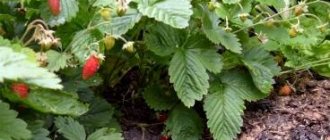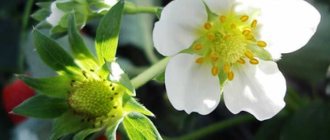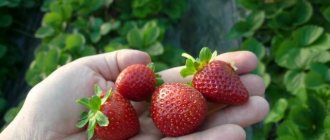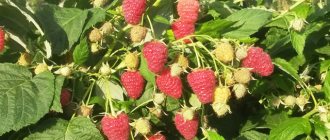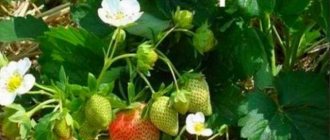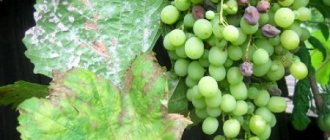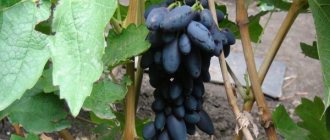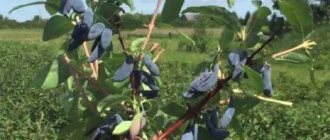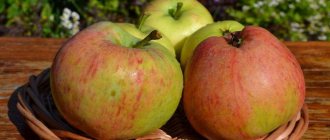Description
Remontant strawberry bushes grow compact with densely crowded foliage. The crown of Ruyana forms a ball shape. The maximum height of the bush is 20 cm. A feature of the remontant variety Ruyana is the high arrangement of peduncles, which is unusual for strawberries. Flowers on high stalks protrude above the foliage level. Gardeners called this feature a plus. The berries always remain clean after rain or watering, since the foliage covers them from below the ground.
Attention! Ruyana strawberries are a remontant variety that cannot be thrown away.
The fruits grow conical in shape. Occasionally, distorted berries are found. The maintainability of the variety already indicates that the fruits are large. The diameter of the berry reaches 1.5 cm. The fruit weighs about 7 g. The ripe berry acquires a bright red color. Small grains are located in deep depressions on the skin of the fruit. The inside of the berry is pink. The pulp is not loose, juicy, rich in forest aroma. Due to their high density, the fruits of remontant Ruyana do not crush during harvesting, transportation and storage.
Young bushes of the remontant strawberry Ruyan begin to bear fruit from the second year after planting in the garden. The stage of rapid flowering occurs in May. The first wave of the crop is harvested in June. Ruyana bushes bloom continuously in warm areas until the third ten days of November. In cold regions, flowering lasts until October. The big advantage of the remontant strawberry variety is its high yield. About 2.5 kg of fruits are collected from 1 m2 of bed.
Attention! The remontant variety Ruyana bears fruit abundantly for four years. Then the bushes need to be renewed, otherwise the berries will be crushed.
Advantages and disadvantages of the variety
An overview of the positive and negative qualities of remontant strawberries Ruyan helps the gardener become more familiar with the variety. For convenience, all parameters are included in the table.
| Advantages | Flaws |
| Long fruiting until cold weather | Grows well only in light soil |
| Tall flower stalks are not contaminated by soil | Fruits become smaller due to lack of moisture |
| No mustache | Bushes need to be renewed every 4 years |
| Variety resistance to fungal diseases | |
| Berries are well stored and transported | |
| Mature bushes are able to winter without shelter | |
| Strawberries easily survive drought |
Picking pots
This procedure has three goals:
- so that the seedlings develop better in the individual space allocated only for them;
- for safety reasons - if some of the seedlings get sick, all the seedlings in the container will not be lost;
- for ease of planting in open ground.
Picking should be done when three leaves are formed on each seedling.
If the containers need to be large, then pots 6x6 cm are sufficient. They must be prepared for transplanting the seedlings. Make holes. Then fill 1/5 full with drainage.
Peat pots for picking will fertilize the soil
After this, you can pour the soil mixture and plant the seeds.
From the moment of sowing until picking, no fertilizers are required for the plantings. A week after picking, you can feed the seedlings with infusion of ash or complex fertilizer.
Methods of propagation of beardless remontant strawberries
The easiest way to propagate wild strawberries and strawberries is by means of tendrils. Since the remontant variety Ruyana is deprived of this possibility, there are two ways left: dividing the bush or seeds.
Dividing the bush
If the remontant Ruyan strawberry is already growing in the yard, then it is easier to propagate it by dividing the bush. The procedure is performed in the spring before flowering begins or in the third ten days of August. For better survival of seedlings of the Ruyany variety, work is carried out on a cloudy day. An adult plant is divided into 2–3 parts so that each specimen has a full root and at least 3 leaves.
The separated parts of remontant strawberries are planted at the same depth as the entire bush grew before. The seedlings are watered abundantly and shaded from the sun. When the divided Ruyan strawberries take root, the shelter is removed.
Growing Ruyana from seeds
You can grow seedlings of remontant Ruyan strawberries from seeds in any container. Boxes, flower pots, and plastic glasses are suitable.
Attention! Any container for growing strawberry seedlings should have drainage holes on the bottom.
The video shows the technology for growing strawberries from seeds:
Seed production technique and stratification
It is better to buy remontant strawberry seeds in the store. If the Ruyana variety is already growing at home, then the grains can be collected from the berries yourself. Large, slightly overripe strawberries without visible damage are selected from the garden bed. Using a sharp knife, cut off the skin of the berry along with the grains. The prepared mass is spread out on glass or a flat plate and placed in the sun. After 4–5 days, the remaining pulp will be completely dry. Only strawberry seeds will remain on the smooth surface. The grains are packed into bags and sent for storage in a cool place.
Before sowing, the seeds of the remontant strawberry Ruyan are subjected to stratification. The procedure involves hardening the grains with cold. Gardeners usually use two methods of stratification:
- Place a thin layer of cotton wool in a regular plastic bag and moisten it with water from a spray bottle. The seeds of Ruyan's remontant strawberry are laid on top of a cotton cloth. The bag is tied and placed in the refrigerator for three days. After stratification is completed, cooled seeds are immediately sown in warm soil.
- The fertile soil is calcined in the oven, cooled to room temperature and scattered on a tray. A layer of snow 1 cm thick is poured on top. You will need tweezers to lay out small grains. Each seed of the Ruyan remontant strawberry is placed on the snow, keeping an interval of 1 cm between them. The tray is covered with a transparent film and placed in the refrigerator for three days. After this time, the crops are taken out and placed in a warm room. The film is removed only after germination.
In nature, strawberries grow when the snow melts. Such conditions are more familiar to her, therefore, to stratify seeds of the remontant variety Ruyana, it is better to choose the second method.
Sowing time
Ruyan's remontant strawberry seeds begin to be sown from early March to mid-April. In warm regions, sowing time is shifted to the end of February. Ruyan seedlings must be provided with artificial lighting, since daylight hours are still short at this time of year.
Sowing in peat tablets
Sowing Ruyana grains in peat tablets can be combined with stratification:
- Peat washers are placed in a plastic container. Pour in melted or settled water, where a pinch of the drug Fitosporin is first dissolved. After the peat discs swell, the planting nests are filled with soil.
- The peat tablets are covered with a layer of snow 1–2 cm thick on top.
- The grains of Ruyan's remontant strawberries are laid out on top of the snow.
- The container with the crops is covered with a transparent film and sent to the refrigerator. The snow will gradually melt and the grains themselves will sink into the soil of the washer's landing nest to the required depth.
- After 2–3 days, remove the container from the refrigerator and place it in a warm room. The film is removed after germination.
- Some of Ruyana’s grains will definitely grow past the peat tablet’s planting nest. Seedlings can simply be removed or replanted after three leaves appear. Each tablet should contain one fathom of remontant Ruyan strawberry.
Before planting, seedlings of the remontant variety are hardened and taken outside.
Attention! Peat tablets tend to dry out quickly. To prevent the seedlings of the remontant Ruyan strawberry from dying, it is necessary to constantly add water.
Sowing in the soil
You can sow Ruyana seeds in the ground in a similar way, combining with stratification. If the grains have already been hardened by cold, then proceed immediately to sowing. Soil is collected from the garden or bought at the store. Any container is used for sowing.
Gardeners came up with an interesting way to grow seedlings of remontant strawberries in Ruyan using snails. Take a tape 1 m long and 10 cm wide. Foamed polyethylene or a laminate backing is suitable. The material must be flexible. Moist soil 1 cm thick is laid out on top of the tape. Stepping back 2.5 cm from the side edge, Ruyan strawberry seeds are laid out on the ground in 2 cm increments.
When the entire section of the tape is sown with grains, it is rolled up. The finished snail is placed in a deep plastic container with the crops facing up. Rolls are made exactly as much as is needed to completely fill the container. A little melt water is poured into the container, the snails are covered with film and placed on the windowsill for germination.
Picking sprouts
Picking seedlings of remontant strawberries Ruyan is carried out after the growth of 3-4 full-fledged leaves. The most acceptable and gentle method is called transshipment. Using a small spatula or an ordinary spoon, dig up a remontant strawberry seedling along with a lump of soil. In this state, it is transferred to another seat, for example, a glass. After picking, the root collar of the seedling is not immediately covered with earth. Only after the Ruyanya strawberries have taken root, soil is added to the cup.
Attention! At the bottom of the picking container, a drainage system made of sand or nutshells must be installed.
Why don't the seeds germinate?
The problem of poor germination of Ruyan remontant strawberry seeds is their poor preparation. Often inexperienced gardeners ignore stratification. Sometimes the problem lies in the poor quality of the grains themselves, collected with one’s own hands from remontant strawberries. If the first crop does not germinate, the procedure is repeated. However, it is advisable to take new soil or disinfect it along with the planting containers, since the crops may have been destroyed by a fungus.
Sowing Ruyana for seedlings
There is nothing unusual about sowing strawberries. It proceeds in the same way as the sowing of any small-seeded civilization. Usually the procedure begins in February, since strawberries take a long time to emerge and develop slowly.
How do they plant Ruyana as seedlings anyway?
- Containers are filled with soil mixture.
- The mixture is moistened and lightly tamped.
- Seeds are placed on top (it’s convenient to do this with tweezers).
- The seeds are not sprinkled with anything, they are only slightly pressed to the ground with the pads of dry fingers.
- Containers are packed in polyethylene or covered with glass.
- They should stand in the light in a warm room, shuttered, moistened, until shoots form.
Strawberry shoots
Landing
When it gets warm outside and the seedlings grow, we begin planting the remontant Ruyan strawberries in the garden bed.
How to choose seedlings
Further productivity depends on good seedlings of remontant strawberries. Seedlings are selected with bright green, intact foliage. There should be at least three of them. Ruyana seedlings are suitable only with a horn thickness of at least 7 mm. The length of the exposed roots should be at least 7 cm. If the seedling was grown in a peat tablet or cup, a good root system will be braided throughout the whole room.
Site selection and soil preparation
The beds for remontant strawberries of the Ruyana variety are located in a sunny place. Light shading by trees is allowed. The soil is dug up with compost at the rate of 1 bucket of organic matter per 1 m2. For looseness, you can add sand. If the area has high acidity, add ash or chalk when digging.
Planting scheme
For remontant strawberries of the Ruyana variety, planting in rows is preferable. A distance of 20 cm is maintained between each bush. The row spacing is about 35 cm. The strawberry variety Ruyana is beardless, so the plants can even be planted in one row near a bed with other garden crops.
Ways to combat diseases and pests
The Ruyana variety has high immunity to fungal diseases - gray rot and powdery mildew. The greatest danger to strawberry plantings is verticillium wilt. When infected, plants begin to wither and dry out for no obvious reason. This disease cannot be cured, so the affected bush must be immediately removed and burned, and nothing should be planted in its place for a year.
Among the pests, snails and slugs that eat fruits and leaves pose a threat to the Ruyana variety. To get rid of them, you need to collect all the parasites and egg laying, and sprinkle the soil with salt or pepper. Lizards and frogs can become assistants in pest control.
Care
The procedure for caring for remontant strawberries Ruyan is the same as for other varieties of strawberries.
Care in spring
In the spring, after the snow melts, the beds are tidied up. Remove old foliage and loosen row spacing. Watering is carried out with warm water, adding 1 g of copper sulfate or the same amount of potassium permanganate to 1 bucket. With the appearance of the ovary, the strawberries are watered with a solution of boric acid at the rate of 5 g of powder per 10 liters of water.
Spring fertilizing is carried out with mineral nitrogen-containing fertilizers. Strawberries respond well to fertilizing with liquid organic matter: a solution of mullein 10 or bird droppings 1:20. During flowering, Ruyana is fertilized with potassium-phosphorus preparations.
Watering and mulching
Remontant Ruyana easily tolerates drought, but the quality of the berries deteriorates. In dry summers, the strawberry plantation is watered daily, especially when the berries begin to set. For watering, choose the evening, preferably after sunset.
To preserve moisture and get rid of weeds, the ground around the bushes is mulched with sawdust and small straw. Gardeners practice covering the beds with black agrofibre as mulch, and cut windows for remontant strawberry bushes.
Fertilizing
Strawberries of the Ruyana variety begin to be fed from the second year of life. The first fertilizing with ammonium nitrate (40 g per 10 liters of water) is carried out in early spring before the formation of flower buds. The second fertilizing with nitroammophoska (1 tablespoon per 10 liters of water) is performed when buds form. The third feeding (2 tbsp. nitroammophoska, 1 tbsp. potassium sulfate per 10 liters of water) is performed during fruit set. Ruyana strawberries respond well to fertilizing with biological products presented in the table.
Frost protection
During flowering, remontant strawberries are afraid of short-term frosts. Greenhouse shelters made of agrofibre help protect plantings. You can also use ordinary transparent film.
Diseases and control methods
The remontant alpine variety is resistant to diseases, but during an epidemic they can appear. The most dangerous diseases and control methods are presented in the table.
Planting in the garden
There is no need to rush to plant strawberry bushes in the ground. Pay attention to the following subtleties:
- choose a good place for seedlings. It should be sunny and calm;
- wait until the soil warms up;
- dig up the soil in the strawberry bed, loosen the top layer well;
- treat the soil with antifungal agents;
- a month before planting, begin the hardening procedure - take the seedlings to the balcony, first for a few minutes, and then for the entire daylight hours;
- make sure that at least eight full healthy leaves have formed on each seedling.
The best time to plant Ruyana seedlings in the garden is the end of April. By mid-summer it will have taken root well. And in the fall it will still produce a few flowers.
Main characteristics of the variety
Some gardeners do not want to plant strawberries on their plot, fearing the difficulties associated with growing them. The difference between the Ruyana variety is that it is quite easy to care for and has a long fruiting period.
Fruiting time, yield
In the description of Ruyan's strawberries, one can find different periods of fruiting, since they largely depend on the climate characteristics of a particular region. In the central part of Russia, berries appear from mid-June and continue to delight until the onset of the first frost.
In terms of its taste and aroma, strawberries are very similar to their forest “relative”, but at the same time they are several times larger in size. In addition, the variety is distinguished by high yield - with proper care per 1 square meter. m. you can easily get 2-3 kg of berries.
Important! Remontant strawberry Ruyana gives a good harvest for 4 years. After this period, planting must be renewed, otherwise the berries will become smaller and smaller. Berries are collected as they ripen, usually once every 3-4 days
The optimal time for collection is early morning, but you should wait until the fallen dew dries
The berries are collected as they ripen, usually once every 3-4 days. The optimal time for collection is early morning, but you should wait until the fallen dew dries
Strawberries should be picked carefully, taking care not to damage the stalk, in order to maintain the integrity of the berries.
Strawberries collected from the garden should be stored in the refrigerator. In this case, the container in which the berry lies must have holes for ventilation. You should not store strawberries in a bag, they will quickly lose their appearance and soften. It is also not recommended to wash the collected berries - this reduces their shelf life by half. Subject to storage conditions, the berry remains fresh for up to 7 days.
Application area
Like other varieties of strawberries, Ruyana is excellent both for fresh consumption and for preparing various preparations for the winter - jam, compotes, etc. It can be added to baked goods, and also used in the preparation of various desserts - milkshakes, jellies, cream.
The berries can be frozen - after defrosting they do not lose their taste. It should be remembered that to prevent strawberries from losing their shape, they should not be washed before freezing, but should be defrosted in the refrigerator.
Dried strawberries are an excellent addition for brewing aromatic tea.
Resistance to diseases and pests
Reviews of Ruyan's remontant strawberry often note its high resistance to the most dangerous diseases that affect garden berries, such as gray rot and powdery mildew.
As for pests that pose a threat to garden strawberries, the main threat is snails and slugs. Compliance with recommendations for planting strawberry bushes and constant weed control helps prevent their occurrence. If pests do appear on the strawberry bed, they need to be collected by hand, and then pest repellents - nettle or salt - should be spread on the ground.
Advantages and disadvantages
The Ruyana variety has a number of advantages:
- fruiting begins at the end of spring and lasts until the onset of the first cold weather;
- the peduncles are located quite high, so the berries remain clean;
- the plant has good immunity to the most dangerous fungal infections;
- the berries are perfectly stored and suitable for transportation over long distances, maintaining their shape and taste;
- the variety tolerates severe cold well and does not require shelter for the winter;
- high yields - from 1 sq. m. you can collect at least 2 kg of berries;
- strawberries grow well both in the sun and in shaded areas;
- The berry can be grown directly from seeds.
A description of Ruyan's strawberries will be incomplete without mentioning some shortcomings:
- Strawberries should be planted in light, fertile soil;
- with insufficient watering of the berries.
But still, these shortcomings can be easily corrected if you follow the recommendations for planting and caring for the plant.
Features of bushes
The description of the Ruyana strawberry variety will certainly intrigue those who like to grow berries on their plots. The bushes have a spherical shape, they are quite compact, growing up to 20 centimeters.
The first feature of the described strawberries is that the bushes have no tendrils at all, so they will not spread throughout the entire bed, which makes care much easier. The second feature is the location of the peduncles. Unlike many similar varieties, the flower stalks of which are located under the leaves, in this variety they are located above the level of leaf growth. Experienced gardeners will understand the beauty of it. The fact is that even after heavy rains the berries will not rot and will remain clean.
Characteristics of the variety
Cultivated Ruyana, unlike its wild “ancestor,” is a remontant plant. It does not grow tendrils and forms very beautiful and neat bushes. They grow no more than 20 centimeters in height.
Ruyana has very compact bushes
The berries have a conical shape. For garden strawberries, they are small, up to twenty millimeters in diameter, and the weight of each berry is 7 grams.
The pulp is of amazing quality - juicy and sweet, the aroma is richer than that of wild strawberries. At the same time, the berry is dense in structure, so the variety is characterized by good transportability and preservation.
Ruyana will bear fruit from the beginning of summer until the first snows, almost without a break for four years. In the fifth year, it is best to plant young seedlings on the strawberry plantation.
The hybrid variety has very high disease resistance. It is practically not affected by botrytis and powdery mildew virus. Ruyan is also not afraid of most strawberry pests.
By purchasing a bag of Ruyana seeds, you can be sure that this particular variety will grow. This is the best way to get good quality strawberries on your plot. And already in the second year you will get a bountiful harvest.
Healthy strawberry seeds of this variety with a normal shelf life and storage conditions have a very high germination rate. Even beginners will not have any difficulties with the emergence of seedlings after proper processing.
The harvest of Ruyan strawberries is very high
Characteristics of varieties
Alpine strawberry "Alexandrina". This is a remontant strawberry that does not form a mustache. Bushes that bloom in May begin to bear fruit in June. The delicious aromatic red berries are harvested before October. About 300 g of berries from each bush! These strawberries are small-fruited, although they are larger than wild strawberries. It contains more vitamins and biologically active substances than most varieties of large-fruited garden strawberries (i.e. strawberries).
Alexandrina can be grown in a garden bed, in a flower bed, in balcony boxes and in flower pots of suitable capacity. They are kept indoors (on a windowsill), on a balcony, or placed on an area near the house, in the garden, etc.
Strawberry seedling of the Alexandrina variety, picked into a peat “tablet”
Strawberry seedling has a long thin root
Alpine strawberry "Ruyana". From June to October, this early variety produces a large harvest of red berries. They are tasty, no less aromatic than wild strawberries. The advantages of the variety include good winter hardiness, drought resistance, and a genetically high level of protection against diseases. “Ruyana” grows well not only on the site, but also in a flower pot (on a windowsill or balcony). Neat bushes are planted in a sunny place from mid-May to the first ten days of June in increments of at least 30 cm.
In addition to these varieties, there are strawberries “Yellow Miracle” (incredibly sweet light cream berries that do not cause allergies), “Ali Baba” (a low bush with fragrant scarlet berries), “Snow White” (a semi-spreading bush with white berries), “Baron Solemacher" (an early-ripening variety with fragrant red berries, one of the most popular), "Rhine Waltz" (an early-ripening variety with bright red berries) and "Rügen" (an early-ripening dessert variety).
Website "Moscow Region", 2012-2019. Copying texts and photographs from the site podmoskоvje.com is prohibited. All rights reserved.
